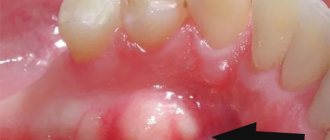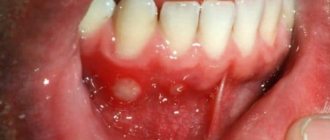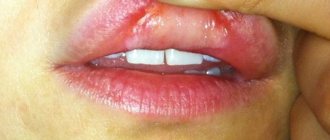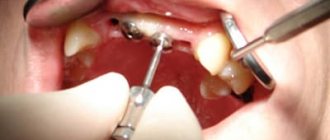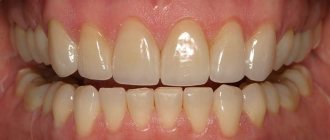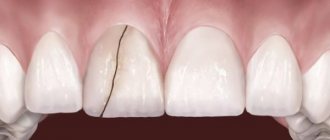What to do if a burn appears on your gum? Possible causes, symptoms and treatment options
A burn to the oral mucosa is an extremely unpleasant phenomenon. Even if the injury is very minor, discomfort and discomfort can persist for a long time. And if the lesion covers a wide area and affects the nerve endings, you definitely cannot do without the help of a specialist in such a situation. Due to the difficulty of isolating injured tissues, there is a serious risk of infection and the development of other equally dangerous complications. Read more about what types of gum burns there are and how to treat them further in this article.
How can you get a gum burn, and what to do in such a situation?
Burns are considered the most painful injuries in medical practice. It is especially unpleasant if they form on the gums.
With untimely or poor-quality treatment, the risk of wound infection increases several times, and this, in turn, entails the development of unwanted complications.
The content of the article:
ICD-10 code - what kind of injury is this and why is it dangerous?
A gum burn is a pathological phenomenon that occurs as a result of contact of the mucous membrane with high temperatures or aggressive chemical factors. The intensity of symptoms and further treatment directly depend on the cause of the injury and its extent. In the International Classification of Diseases, 10th revision (ICD-10), this phenomenon is assigned the following codes:
- T28.0 Thermal burn,
- T28.5 Chemical.
A burn to the oral mucosa is an extremely unpleasant phenomenon.
Every person has accidentally burned himself with hot food or drink at least once in his life. But despite the prevalence of this phenomenon, in reality it can lead to very serious complications. A wound on the mucous membrane opens a direct path for infection, and with significant damage to soft tissue there is a real risk of developing necrosis. In such a situation, it is necessary to remove the affected areas as quickly as possible in order to prevent necrotic processes from spreading further. Here you already need emergency help from a specialist.
The oral mucosa is a sensitive and delicate tissue. It contains a developed network of tiny capillaries, which are directly involved in the nutrition and maintenance of the vitality of the dentogingival ligamentous apparatus. Therefore, serious damage to the mucous membrane in this area is fraught with the development of dangerous periodontal diseases and even tooth loss.
Expected Result
The duration of treatment depends on the type and severity of the burn. Only the attending physician can give an accurate prognosis. On average, the course takes from 7 to 30 days.
Untimely treatment of a chemical burn entails aggravation of the patient's condition. The gums become very swollen and red, and the symptoms worsen. Prolongation of the situation can lead to tissue necrosis or infection.
During the treatment period, it is very important to monitor oral hygiene and minimize the consumption of too hot food or drinks. Otherwise, you may get a new burn.
Why a burn may occur - reasons
There are many potential prerequisites for receiving such an injury. The cause may be the use of powerful medications, accidental contact of the mucous membrane with chemicals, incorrectly performed dental treatment, or a trivial case - consuming too hot foods or drinks. Another common situation is that the gums are burned by alcohol tincture while rinsing the mouth. In pediatrics, there are often cases where children receive burns due to the ingestion of household chemicals.
Causes
The mucous membrane in the oral cavity is very delicate and thin. Any mechanical impact causes minor damage or cracks to form on it. Under the epithelium there is a huge number of thin capillaries and nerve endings.
That is why a burn on the gum is always accompanied by severe redness and pain. Such an injury is difficult to treat due to the impossibility of constant aseptic treatment.
During the treatment of many dental diseases, doctors use medications or special techniques that can cause cauterization of the gum mucosa in the mouth.
Burns also often occur when medications are abused during self-medication (applying analgin to a painful area, rinsing with alcohol solutions, etc.).
What symptoms occur?
When the mucous membrane is damaged as a result of exposure to high temperatures, sharp pain occurs. This burn often appears on the tongue or palate. In this case, the surface within the affected area turns red and becomes slightly rough. Later, bubbles with a colorless liquid may appear in this place. After a rupture, painful ulcers remain in their place. This is what a gum burn looks like caused by contact of the mucous membrane with a hot drink or food.
The photo shows a gum burn
When exposed to chemicals, the injured area sharply turns red and swells. If the provoking factor is not removed in time, the lesion can spread to the deep layers of the mucosa and cause tissue necrosis.
Forms of defeat
Depending on the cause of the burn, they are divided into two main groups - thermal and chemical. Dentists also include alcohol burns and damage from arsenic in the classification.
They all differ in their symptoms and course; let’s look at each in more detail.
Thermal
Develops under the influence of high temperatures, electric current or laser radiation.
The gum is a kind of barrier that protects the root and the tooth itself from unnecessary damage. Soft tissue injury leads to the development of undesirable consequences.
Every person has suffered a thermal burn to the gums at least once in their life. This occurs when hot drinks or dishes are consumed carelessly . Very often, this type of injury affects women who, when cooking, taste the food beforehand without cooling it.
Upon contact with a source of high temperature, a strong burning sensation . Other symptoms include the formation of ulcers, blisters or bumps on the damaged area .
After such formations burst, ulcers form in their place, which become infected if not properly cared for.
It is worth noting that children are often exposed to thermal burns. They are the ones who put foods into their mouths that can be very hot. Therefore, parents need to carefully measure the temperature of food intended for the child's consumption.
Chemical
It develops against the background of the action of aggressive substances; it is also called medicinal. In addition to contact with the gums, chemical components can enter the stomach and esophagus and cause severe burns in them.
This type of damage most often develops during the treatment of dental diseases. Patients independently use medications to relieve pain attacks (apply an analgin tablet, etc.).
Types of burns on the oral mucosa
Such a pathological phenomenon can result from the influence of a variety of factors. Let's consider the most common types of such injuries and the prerequisites for their occurrence.
Heat injury
This kind of trouble can happen if, for example, you take a sip of too hot tea or coffee without looking. Due to the fact that the mucosal epithelial cells are filled with moisture, when they come into contact with heat, symptoms develop very quickly:
- blisters with liquid of different sizes form,
- the mucous membrane acquires a rough texture,
- persistent aching pain appears, a feeling of constant discomfort, which intensifies at the moment of touching the sore area,
- the blisters burst and reveal open wounds - erosion.
Burns can occur from too hot tea or coffee
“Once a blister appeared on my gum, I was so scared, I thought it was gumboil or something like that. It's so painful, it's a nightmare! I ran to the doctor, and it turned out that it was just a burn. The day before I took a sip of hot tea and forgot about it. And the next morning you have a blister! The doctor said to rinse with chlorhexidine and chamomile, everything will go away. And so it happened, for about five days the gums were healing, it was painful, but not fatal.”
Lyudochka78, from correspondence on the woman.ru forum
As a rule, in domestic conditions, thermal burns of the gums do not lead to serious consequences and heal relatively quickly. However, if acute unbearable pain occurs, it is better to see a doctor as soon as possible.
Chemical damage at work
One common type of chemical injury is a work-related injury. This problem is often faced by employees involved in hazardous industries, as well as builders and molarists. Damage to the mucous membrane occurs as a result of its contact with acids, alkali and metal salts, as well as toxic fumes.
Other types of chemical injuries
Such pathological phenomena can have a variety of etiologies, not only industrial ones. The main danger also lies in the fact that dangerous substances, together with saliva, can easily penetrate the esophagus and stomach, and therefore lead to extensive damage to internal organs, the opening of internal bleeding, the development of ulcers and pancreatitis.
This category should also include injuries sustained due to doctors’ improper technique for performing medical dental procedures, including fillings, nerve removal, or whitening. In such cases, damage may result from too long contact of soft tissues with disinfectant solutions, or as a result of intense exposure to a laser or polymerization lamp.
Mistakes made during the whitening procedure can also cause burns.
A chemical burn of the gums often manifests itself somewhat differently than a thermal burn. In this case, the patient does not develop blisters, but noticeable swelling appears, especially around the circumference of the injured area. Patients often complain of excruciating pain and itching from the inside1.
Prolonged contact with alcohol
The cause of injury can be prolonged contact of the mucous membrane with alcohol. This often happens when the technique of performing therapeutic procedures using alcohol lotions or rinsing with alcohol-containing solutions is violated.
Domestic injuries
In domestic conditions, you can get both thermal and chemical burns. For example, it is not uncommon for young children to be admitted to the intensive care unit with serious injuries caused by exposure to hazardous chemicals in the oral and esophageal mucosa. Therefore, all household chemicals must be stored in places inaccessible to children. Among other common everyday causes, experts highlight the use of unlicensed dietary supplements, low-quality toothpastes and other hygiene products.
Long-term exposure to arsenic
Previously, depulpation of teeth, that is, removal of nerves from them, was often carried out using arsenic. Special compounds based on this toxic substance were placed in the tooth for several days in order to kill the pulp and subsequently remove it painlessly. The patient had to appear for the appointment strictly on the appointed day. But many continued to walk around with arsenic in their teeth, ignoring the doctor’s instructions. Such irresponsibility often led to damage to nearby tissues and even to their necrosis.
Burns can occur from exposure to arsenic
Now in modern dentistry, safer and more gentle devitalizing pastes are used for this purpose. They do not contain arsenic compounds, but they still contain quite powerful components. If, after using such a substance, you experience obvious pain and other suspicious symptoms, immediately go to the doctor to prevent dangerous consequences.
Symptoms
The disease develops gradually:
- Initially, the shine and pigmentation of the tooth enamel is disturbed, and gum tissue moves away from the tooth (see also: tooth pigmentation and caries in the stain stage).
- In the middle stage, swelling, bad breath, and enlarged lymph nodes appear. The patient is concerned about fever, bleeding and gray plaque on the gums. Gradually they become covered with ulcers, turn black, and the teeth begin to loosen (see also: for what reasons does tooth enamel darken?). The patient experiences insomnia, nervous disorders, and anxiety.
- At the last stage, swelling of the inflammation zone is noticeable. When tissue dies, bone structures are exposed and a foul odor appears. Worries about fever, dyspeptic disorders, which result in loss of chewing functions.
Stages of burns on the mucous membrane
In dentistry, this pathological phenomenon is classified into different stages. Let's look at each of them in a little more detail:
- first - soft tissues turn red, discomfort and unpleasant sensations occur, especially when touching the affected area,
- the second – blisters filled with clear liquid form on the mucous membrane. When they burst, there is a painful sensation that can radiate to the teeth,
- third, in such a situation the symptoms described above appear, but in a more intense form. At this stage, the risk of soft tissue necrosis increases significantly.
Thermal burns received in domestic conditions most often belong to the first stage. But chemical injuries, including industrial ones, can have very serious consequences. Self-medication in such a situation can lead to serious and irreversible consequences, so it is important to see a specialist as quickly as possible.
Severity
Doctors distinguish 3 degrees of severity of gum burns:
- First . There is not a pronounced redness of the gums and mucous membranes, swelling at the site of the lesion and pain when touched.
- Second . The swelling becomes pronounced and bubbles form on the gums, which contain exudate. The mucous membrane is bright red and there is constant pain.
- Third . In addition to the symptoms described above, infection of the affected gums will also appear, as well as the pathological process of death of the affected tissues.
If measures are not taken in a timely manner, with a chemical type of burn, the gum tissue will die. Severe irritation will occur, and the mucous membrane will become very red.
Negative consequences will be:
- development of necrosis;
- tissue death;
- destruction of the jaw;
- deformation of the facial part.
How is diagnostics carried out?
To make a diagnosis, the doctor conducts a visual examination of the damaged area, and also collects an anamnesis from the patient’s words to establish the cause of the pathological phenomenon. If the lesion is the result of chemical exposure, its symptoms may resemble an allergic reaction, for example, to substances such as plastic, metal or amalgam. Therefore, in such cases, differential diagnosis is carried out.
For diagnosis, you should contact your dentist
Principles and tactics of treatment
Treatment will directly depend on the cause of the injury, its severity and stage. If it is a minor injury, professional help may not be required. But the second and third stages require the mandatory participation of a doctor.
Medication therapy
It is better to consult a specialist personally about how to treat a gum burn. In such cases, antiseptic rinsing solutions are usually prescribed, for example, Chlorhexidine, Miramistin or Furacilin. As an analgesic for topical application, the doctor may prescribe 10% Lidocaine - it is recommended to use the drug every 7-8 hours.
In such cases, antiseptic rinses are usually prescribed.
Multivitamin complexes with the obligatory content of retinol, vitamins E and C can also be prescribed. They stimulate the healing processes of affected tissues and their regeneration at the cellular level.
When is surgery required?
With severe and extensive lesions, the main danger lies in the high risk of developing necrotic processes. To prevent the spread of pathology to healthy tissue, an appropriate operation is performed to remove dead areas. The advisability of such intervention remains at the discretion of the attending physician.
Traditional medicine
The use of any products prepared independently based on medicinal plants must be agreed with a doctor. For additional antiseptic treatment and acceleration of healing processes, rinsing with decoctions of chamomile, oak bark and St. John's wort, as well as compresses with sea buckthorn oil, are usually recommended.
Herbal decoctions can be used at home
Treatment of gum burn
The intensity of therapy and duration are individual for each specific case. Don't put off visiting the dentist. The faster medical assistance is provided, the more effective the treatment will be. Having felt the symptoms of a burn, the patient must provide first aid to himself, following the instructions:
- Spit out any remaining substance that causes tissue irritation.
- Rinse your mouth thoroughly with warm, boiled water several times.
- If necessary, take a pain reliever.
If the gums have been burned by acid, its effect must be neutralized by rinsing the mouth with a 0.01% solution of ammonia. If the burn is of alkaline origin, then it is worth making an acidic solution using citric or acetic acid.
Further therapy is carried out under the supervision of a dentist. Most often, to eliminate unpleasant symptoms, the patient is prescribed the use of several groups of drugs.
For rinsing
- Furacilin;
- Chlorhexidine;
- Hydrogen peroxide.
Furacillin solution
Ointments
- Metrogyl denta;
- Solcoseryl.
ethnoscience
- Rinsing with decoctions of medicinal herbs (chamomile, violet, St. John's wort);
- Lubricating the affected areas with sea buckthorn oil.
During treatment, doctors recommend avoiding hot, spicy and too hard foods, which can damage mucous tissues. If a burn is left unattended, it can fester and further injure the inflamed areas. On the contrary, timely treatment of burned areas will eliminate pain as quickly as possible and prevent possible complications.
General recommendations from experts
Summarizing all of the above, we can identify several universal directions in the treatment of such lesions, regardless of their etiology. In such cases, rinsing with antibacterial solutions, such as Chlorhexidine and Furacilin, as well as rinsing with decoctions of chamomile and St. John's wort are usually prescribed. Gels and ointments with an analgesic effect, for example, Kalgel or Dentol, and wound-healing applications using Metrogyl Denta or Solcoseryl are prescribed as local preparations. To relieve pain, you can take painkillers as prescribed by a doctor - Ketarol, Nurofen or Nise.
Features of the treatment of chemical burns
If you have been exposed to aggressive chemicals, you should be especially careful - some components react when in contact with water. Therefore, in such cases, rinsing should be done with a small amount of water at room temperature and only after consultation with the attending physician. A couple of drops of apple cider vinegar will help neutralize the lye. And in case of an acid injury, I recommend rinsing with a solution of baking soda and then applying a cold compress to the injured area.
Nuances of treatment after thermal exposure
Therapy will largely depend on the type of thermal injury. If it was caused by careless consumption of a hot drink or food, you can alleviate the condition by rinsing your mouth with cool water. If the nerve endings have been injured, a small piece of ice will help relieve acute pain. But in such cases, it is better not to experiment - take a painkiller tablet and immediately see a doctor.
If the pain is severe, you can take a painkiller tablet
Treatment
Treatment for gum burns depends on the following factors:
- degree of damage;
- the reason that provoked the condition;
- the patient has dental disease;
- disturbing symptoms;
- patient characteristics – age, presence of concomitant diagnoses, exacerbation of chronic diseases, etc.
Basic remedies for oral burns:
- antiseptics;
- healing drugs;
- dental gels;
- painkillers.
It is also necessary to follow a gentle diet, excluding salty, sweet, spicy, cold, and hot foods.
First aid
Measures depend on the type of gum damage, stage, and symptoms.
In case of thermal burn from hot drinks or dishes, it is necessary to rinse the mouth with cool water to remove food debris and reduce the temperature. After a minute, the water is spat out and the procedure is repeated. In case of pain, you can apply pieces of ice to freeze the nerve receptors and relieve discomfort.
For chemical exposure, first aid depends on the compounds that caused the burn. If it is caused by acid, then for rinsing take warm water with the addition of baking soda and ammonia. You can then apply an ice compress.
If the damage is caused by alkali, then acetic or citric acid dissolved in water is used for extinguishing. To eliminate phenol, use castor oil or ethyl alcohol in a 1:1 ratio.
In case of chemical burns, it is extremely important to visit the clinic for examination and further comprehensive treatment.
Drug treatment
When gums are damaged, the following groups of medications are used.
- Antiseptics
To reduce infection and prevent complications, rinse with antiseptic solutions: furacillin, solutions of chlorhexidine or miramistin, chamomile, calendula, diluted tincture of rotokan, stomatophyte. The procedure is performed after eating.
- Dental gels
To quickly relieve pain, Kalgel is used topically. For healing, you can additionally use Cholisal, Solcoseryl dental paste. They are applied with a clean cotton swab or finger to the affected surface after rinsing.
- Regenerating drugs
For necrosis, the appearance of wounds, erosion, these medications are necessary: Solcoseryl, walnut or sea buckthorn oil, Malavit.
- Analgesics
Drugs with analgesic and anti-inflammatory effects are taken immediately to relieve pain. These include Nurofen, Mig, Nise, Analgin, Nimesil, etc.
With the development of necrosis and persistent infection of the affected tissues, the periodontologist may prescribe antibiotics in the form of tablets, capsules, or injections.
In case of tissue necrosis and exposure of the jaw bones, treatment is performed surgically.
ethnoscience
At home, rinsing with decoctions of calendula, chamomile, and St. John's wort is widely used. Additionally, the gum surfaces are treated with sea buckthorn oil for rapid healing.
Other traditional medicine measures for gum burns are unacceptable: the patient needs qualified, timely medical care and comprehensive treatment.
How long does it take for a gum burn to heal?
Damage to the oral cavity resolves over different periods of time in different patients. This is influenced by the stage, form, symptoms, cause, general condition of the person and other factors.
The average healing time is 2 weeks with correct timely treatment.
A gum burn is a dangerous condition that can be caused by eating too hot food or chemicals. If it occurs, it is necessary to consult a specialist to prevent complications, aggravate the course of the disease, and quickly cure.
How to avoid serious consequences
To avoid serious complications at home, you must strictly follow all the doctor’s instructions, take all medications prescribed by him and follow an appropriate diet. Dental experts provide several important recommendations in this regard:
- During the recovery period, it is recommended to observe some dietary restrictions. So, for example, you will have to give up foods that can cause irritation of the mucous membrane, namely hot, salty, spicy and acidic foods. It is also better to refrain from hard, too cold and hot foods and drinks,
During treatment you should avoid eating acidic foods. - During rehabilitation, you should stop taking any extraneous medications so as not to provoke an undesirable reaction,
- household chemicals, paints and solvents, as well as building materials should be stored in a separate, well-ventilated area. If your work involves contact with caustic fumes, it is better to take a short vacation until the tissues are completely restored.
If the pain intensifies, you should consult your doctor again. With extensive lesions, there is always a risk of infection and the development of complications, so your condition must be monitored very carefully.
Degrees and clinical picture
Like all types of burns, such gum injury is also classified into 3 stages:
- First.
It is characterized by slight local redness of the tissues, their swelling and mild pain from touching the damaged area. Despite the fact that this stage goes almost unnoticed for a person and is easily tolerated, the condition and its treatment cannot be ignored. - Second. It is characterized by the appearance of blisters with a transparent liquid substance inside. When the bubble bursts, the person feels a sharp pain that covers the teeth.
- Third. The heaviest of all. Combines the symptoms of the first two and is characterized by the onset of necrotic changes. The gum mucosa becomes covered with multiple blisters, which, when opened, lead to discomfort and pain.
Important! If you notice symptoms of a burn, you should immediately seek medical help.
A timely and correctly selected course of treatment will help quickly eliminate unpleasant symptoms. Self-medication slows down recovery and can worsen the situation.
How to care for your mouth after an injury
It is important to maintain a high level of hygiene to prevent infection of damaged tissue. Here are a few rules that must be followed:
- every day, morning and evening, brush your teeth with a suitable brush and toothpaste,
- do not forget to clean plaque and food debris from the tongue,
- rinse your mouth every time after eating,
- limit the consumption of sweet and starchy foods, which contribute to faster plaque formation.
Proper dental hygiene is important to maintain a smile.
A burn to the gums can result in a host of serious problems if you do not respond to the problem in time and consult a doctor. Remember that only timely and adequate treatment can prevent undesirable consequences and dangerous complications.
1Ivanova E. N., Kukushkina E. A. Diseases of the oral mucosa. Textbook, 2007.
Reviews
Patients who have experienced thermal or chemical burns of the gums complain of severe pain and some difficulties in treatment. Many people prefer home remedies, which causes the condition to worsen.
Third degree burns are rarely recorded, but their treatment takes longer and is much more difficult. For first and second degree injuries, it is enough to carry out medical treatment using drugs that will be selected by the attending physician.
If you have already experienced a gum burn, you can share your treatment experience by leaving a comment on this article.
